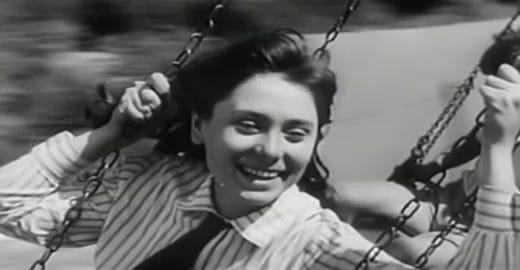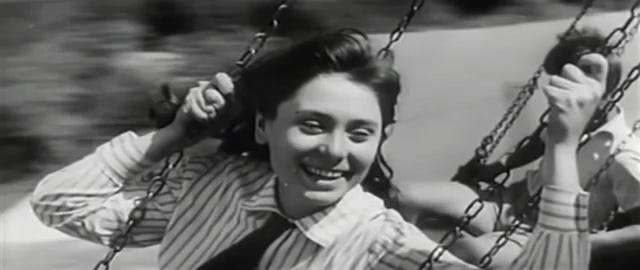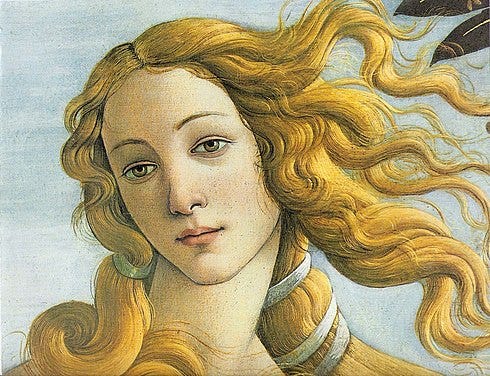Preface to the Preface: Dragan Tenev’s birthday comes this week on 12th of April 1919. To celebrate him, I present to You, in both English and Bulgarian, his direct message to us, his Readers, in his own Preface to his book "Small Stories About Great Artists". It was published in 1981 in Sofia, Bulgaria, two years before his only child, a lovely young daughter, passed away after 5 years battle with cancer. Her name was Severina Teneva, a known actress in Bulgaria: https://www.imdb.com/name/nm0854958/
She loved the swings just like I did as a child. Tenev’s testament left all he had to her college in Sofia, The National Academy of Theatre and Film Arts “Kr. Sarafov” https://natfiz.bg/en/
Dragan Tenev’s daughter Severina Teneva (30.09.1945 - 12.11.1983) in the film “Цар и Генерал” (King and General), 1966.
Is that why he chose a close up of the calm but melancholic face of Simonetta Vespucci as Venus in Sandro Botticelli’s Birth of Venus for the cover of his book? Because Simonetta passed away so young and lovely too? This is what I felt when I saw the cover of his book in the attic, that it represents each one of us, every daughter and son in the world. We can only feel how Tenev coped with his private sorrow. He told my aunt in the summer of 1984, when I had my boring exams on communism while the rest of the family went on vacation in Kiten by the Black Sea, that it was hard, especially, for his wife, who missed most meals. Yet, my aunt remembered, that he was kind to her and made jokes with my little cousin at lunch.
Tenev must have worked on this book for years but I believe that we, usually, write the preface when the work is done.
Sandro Botticelli. Birth of Venus. Detail. 1484-1486. Uffizi Galleries, Florence.
IN THE MEMORY OF MY PARENTS,
To whom I owe all the good
in my life.
Dragan Tenev
DEAR READER,
The book you hold in your hands is not dedicated to the works of the artists - heroes on its pages, but rather an attempt to tell you about them, mainly, as people. At the same time, I must immediately add - despite my experience gained in dealing with "biographical facts" - I myself am not in a position to firmly guarantee before you, how far the "story" ends in my book and where the "legend" begins. You know, the lives of great men have always interested all other people. Thanks to this interest in truth, so much has been accumulated about them, composed by their admirers themselves, so that we do not have to go back to the ancient Greek "life descriptions" to give me the right. The example of Maria Callas, Picasso, Greta Garbo, or any of our other contemporaries of the same magnitude eloquently confirms my words. This is how we are!
In the last 5,000 years, we have not yet lost our taste for the curious, the spicy or the extraordinary. And, of course, the pile of nonsense about our favourites from the "spiritual realm" is, already, about as high as the Great Pyramid. Of course, at the same time, science makes it possible to debunk many of the myths about these people, but, unfortunately, the archives of mankind in the 5,000 years mentioned were not at any height, and thousands of documents that would put "order" in this area have perished. In addition to what is said now, do not forget - for those who want to "dive" professionally into this "chaos" is added the moment of contradictions in biographical sources, the many different interpretations of certain questions and, last but not least, the enumeration of the different points of view of researchers on the same topic.
One illustration - many modern scholars seriously accuse Vasari of "writing" or of using facts told to him by others "in trust". Such drastic case, for example, is considered the story surrounding the discovery of Giotto di Bondone! But in my checks "in the dust of time", I came across the famous "Commentaries" of the sculptor Lorenzo Ghiberti – the closest at the time "art historian" to Giotto, who verifies the "version" of the shepherd boy from Vespignano and the Florentine artist Cimabue in an indisputable way! Then what?
Then I decided to rely, mainly, on my intuition in the controversial cases and, as a person who has been dealing with controversial facts for a long time, to go not on the path of formal-logical interpretation, but to answer the question in each case: was this or that possible, given the general context of a characteristic of the artist in question? Following this method, within the framework of the moral, ethical, political or aesthetic norms of the individual estates, I tried, most carefully, to give them a real assessment, to accept them as possible or not. Have I succeeded everywhere? Not out of modesty, I say, I'm not sure! In any case, however, I can assure you of something else - I put a lot of work into these "psychological surveys" for each artist, starting first from his works. The attitude of an artist to an event, a person or a group of people depicted in his paintings speaks quite a bit about the auteur himself, about his attitude to the world and the affairs of life.
Fortunately, I have had the wonderful opportunity to see for myself many of those works that are described in my book. This almost material touch with the original creative work of the people I talk about later proved to be of inestimable benefit to me. In special science books written on the nature and importance of the works of individual artists for the development of art, researchers talk or argue often about issues that are beyond the thinking of most amateurs, who actually "consume" the art itself. Art is meant, mainly, for them and if it needs to be explained to them, in my opinion, things become quite complicated.
In the book, which I offer to you, I have set myself the opposite task — to show mainly the creators of the great works in the history of painting first of all as people, and, at the same time, to make you interested in their works. Or, in other words, to connect the "living people" with their eternally living works! If I have achieved that, it will be for me the best compensation for the work this book has cost me.
Recently, some dark prophets in the West have denied the importance of art as a necessity in people's lives and proclaimed its "withering away." This, of course, is completely wrong, because art, for as long as man has existed, has always been the universal language in which people all over the globe have communicated. The human heart is the same everywhere on earth, regardless of skin colour, and I believe that there is no human heart that does not care about truly great art.
Dragan Tenev
В ПАМЕT НА РОДИТЕЛИТЕ МИ,
на които дължа всичко добро
в моя живот.
Драган Тенев
ДРАГИ ЧИТАТЕЛЮ,
Книгата, която държиш в ръцете си, не е посветена на творбите на художниците - герои на нейните страници, а по-скоро опит да ти разкажа за самите тях предимно като хора. Заедно с това трябва веднага да добавя - въпреки моя натрупан в боравенето с „биографични факти“ опит - аз самият не съм в състояние да поръчителствувам твърдо пред теб, докъде свършва „историята“ в книгата ми и откъде почва „легендата“. Знаеш и сам - животът на великите личности винаги е интересувал всички останали хора. Благодарение на този интерес към истината за тях се е натрупало и толкова много, съчинено от самите техни почитатели, тъй че не е нужно да се връщаме до древногръцките „животоописания”, за да ми дадеш право. Примерът с Мария Калас, с Пикасо, с Грета Гарбо или който и да е от останалите ни съвременници от същата величина красноречиво потвърждава моите думи. Такива сме!
В последните 5000 години все още не сме загубили вкуса към куриозното, към пикантното или необикновеното. И естествено грамадата от небивалици за нашите любимци от „духовната сфера” е вече приблизително колкото Хеопсовата пирамида. Разбира се, паралелно с това науката същo прави възможното да развенчае много от митовете за тези хора, но за съжаление архивите на човечеството през споменатите 5000 години не са били на особена висота и хиляди документи, които биха сложили „ред“ в тази област, са погинали. Освен казаното сега, не забравяй - за онзи, който иска да се „гмурне“ професионално в този „хаос“ се прибавя още и моментът на противоречията в биографичните първоизточници, множеството най-различни тълкувания на определени въпроси и - не на последно място - безброят на различните гледни точки на изследователите по същите въпроси.
Една илюстрация - много съвременни учени обвиняват сериозно Вазари в „съчинителство“ или пък в използуване на факти, разказани му от други „на доверие". 3а такъв драстичен случай например се смята историята около откриването на Джото ди Бондоне! Но ето, че при моите проверки „сред праха на времето", попаднах на известните „Коментарии" на скулптора Лоренцо Гиберти — най-близкият по време „историк на изкуството" до Джото, които потgърждават „версията" за овчарчето от Веспиняно и флорентинския художник Чимабуе по безспорен начин! Тогава?
Тогава реших да се опра npu спорните случаи главно на своята интуиция и като човек, боравил дълго време със спорни факти, да тръгна не по пътя на формално-логичното тълкуване, а да си отговарям при всеки отделен случай на въпроса: възможно ли e било „това" в общия контекст от характеристика на художника, за когото става дума? Следвайки този метод, в рамкитв на моралните, етичните, политическите или естетическите норми на отделните eпоxи, аз се стараех най-внимателно да им давам една реална оценка, да ги приемам за възможни или не. Дали навсякъде съм успявал? Не от скромност казвам — не съм сигурен! Във всеки случай обаче мога да те уверя в друго - положих много труд в тези „психологически анкети" за всеки художник, тръгвайки най-напред от произведенията му към самия него. Отношението на един творец към дадено събитие, лице или група от xоpа, изобразени в картините му, говори немалко за самия ав- тор, за отношението му към света и житейските дела.
За щастие имах през живота си чудесната възможност да видя сам много от онези творби, които са описани в моята книга. Този почти материален допир до оригиналното творческо дело на хората, за които разказвам по-нататък, се оказа от неоценима полза за мен. В специалните научни книги, написани върху същността и значението на творбите на отделните художници за развитието на изкуството, изследователите говорят или спорят често по въпроси, които са извън рамките на мисленето на повечето любители, които в същност „консумират" самото изкуство. A то e предназначено главно за тях и ако no начало трябва да им се обяснява, по мое мнение работите се услoжняват доста.
В книгата, която ти предлагам, аз си поставих обратната задача — да покажа главно създателите на великите произведения в историята на живописта преди всичко като хора, а заедно с това да mе накарам после сам да се заинтересуваш от техните произведения. Или с други думи, да свържа „живите хора" с вечно живите им творби! Ако съм постигнал това, то ще бъде за мен най-добрата компенсация за труда, който ми струва тази книга.
Напоследък някои мрачни пророци на Запад отричат значението на изкуството като необходимост в живота на хората и обявяват неговото „отмиране". Това естествено е напълно погрешно, защото изкуството, откакто съществува човекът, винаги е било универсалният език, на който са общували хората по цялото земно кълбо. Човещкото сърце е еднакво навсякъде по земята независимо от цвета на кожата и аз вярвам, че няма човешко сърце, което да не се вълнува от истински голямото изкуство.
Драган Тенев





